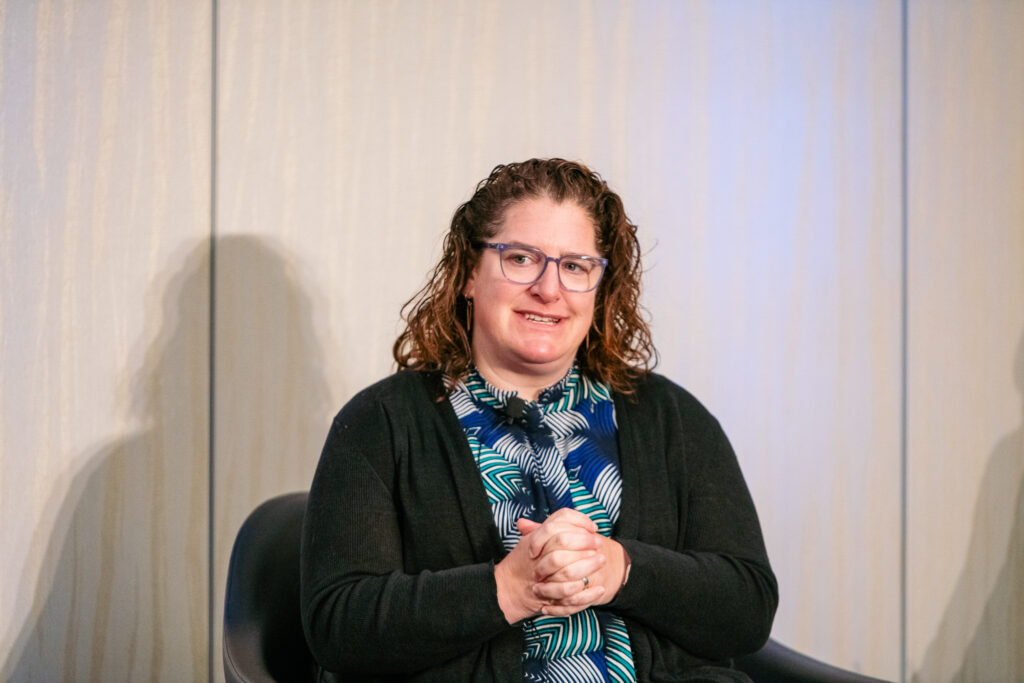
This article is a part of your HHCN+ Membership
Dr. Pippa Shulman, the chief medical officer at Medically Home, believes the home will eventually become the lynchpin of the U.S. health care system.
“What you’re going to see is a full shift to the idea of hospitals, as a place where you seek ICU care, surgical care and emergency care for trauma, but that everything else can be delivered in the home,” she recently told Home Health Care News.
At Medically Home, Shulman and her colleagues have worked to drive the hospital-at-home movement forward by helping a number of health care organizations enter the space and scale.
Shulman discussed this during an interview with HHCN, which took place during the FUTURE conference last week. During the discussion, Shulman also touched on why it’s important to embrace technology that is actually helping clinicians solve problems, and her predictions around the future of the Centers for Medicare & Medicaid Services’ (CMS) Acute Hospital Care at Home waiver.
HHCN: Can you talk about how you’ve seen hospital-at-home establish itself as a notable care delivery model in broader health care, and what this has meant for patients?
Shulman: What people don’t realize is hospital at home has actually been a care delivery model in this country for more than 20 years, just generally on a small scale, and usually in health systems that have integrated payer networks, or that are like the VA. There had been a lot of slowly growing interest, really brewing in 2017, 2018. Right around that time, CMMI put out a demonstration grant opportunity that Mount Sinai and the Marshfield Clinic took advantage of.
About that time was also when I was establishing a program in Massachusetts. We all know what happened just a few years later, which was the Covid pandemic. With the sudden need for capacity in space, home hospital was ready. That was really the turning point.
The second turning point was when CMS issued the waiver allowing for reimbursement. That was such a missing piece to this story, and then you had a rush into the space from all sorts of interested parties, which was wonderful. It allowed for small systems and big systems to get involved where they might not have, and it allowed for Medicare reimbursement, which had really not been a part of the play until that point. Now, you have 10 states where Medicaid is reimbursing for home hospital. The outcomes are terrific. The data keeps coming in really strong. The pandemic was such a terrible moment for our health care system, but that moment allowed for this incredible time of innovation.
In your view, how has Medically Home moved the needle forward in the larger hospital-at-home movement?
I came to this as a primary care provider, but I also was doing home-based medical care. I ran a home-based primary care, home-based post-acute care, a SNF program, and worked for an organization where my goal was to keep my patients out of the hospital.
When we were looking to set up a home hospital program, we needed help with logistics and technology. Technology is a bit of a commodity. You can get that from anywhere, but how do I get oxygen in the middle of the night to my patient’s bedside? How do I get blood drawn when I need it, and get it transported? Home nurses are a wonderful resource, but many of them only travel with the supplies they need that day, and often can’t respond to an emergency situation despite the fact that many of them want to, and so you have to retool an entire system.
That’s really the idea of Medically Home. How can we support logistics and the coordination of care, so that a physician in the hospital doesn’t have to worry about whether the care is going to get there?. It is really allowing for the extension of that hospital’s brand, so to speak, right into the home. That’s the power of the model, and the missing link for so many that want to scale and build, particularly for smaller or mid-sized health systems.
Partnerships are crucial to the company, as Medically Home helps companies scale their hospital-at-home programs. What should companies that want to move into this space be looking for in a partner?
We partnered with a number of wonderful national partners in the home health care space. I think it is, first of all, really looking beyond traditional home care.
We are not talking about the home health episode in an OASIS form anymore. I know a lot of people are saying that, but I think that’s really No. 1. It is thinking about your workforce in a different way. How do I need to upskill my workforce? How do I need to potentially add new competencies to my workforce, and be able to respond to dynamic needs of a home hospital program? The home hospital program may start out taking care of older patients with acute exacerbation of chronic disease, but they’re going to quickly morph into wanting to take care of post-surgical patients, younger patients and cancer patients.
Can you adapt with them to be able to provide those services? Can you develop cooperative education agreements? Can you help source supplies? Can you take care of more than one need? Maybe you came in with skills around nursing, but are there skills that you can add to your wheelhouse that maybe you didn’t have before. It’s still about problem solving, and coming up with new solutions.
What are some clinical challenges you believe that hospital-at-home should be focused on?
One clinical challenge I think about a lot is — as people are getting more and more interested in care that comes into home, there’s a lot of money and focus on technology, sensors, remote patient monitoring. We need to make sure that if we’re going to put something in a patient’s home, that we are getting clinically actionable, accurate data from it, and that it’s safe to use.
I worry about the proliferation of technology that’s of little use. I want to make sure that we’re developing technology that is actually solving a problem we have, and that is able to replace and add to the home hospital environment, not just solve a doctor’s anxiety.
Similarly, I think about things like point-of-care testing. If we really want to expand the services we can provide in the home, we need to make sure that we can get testing and results as close to the patient as possible, to reduce the time from assessment to diagnosis to treatment.
We already know we can get plain film X-ray and ultrasound. They’re already working on things like CT in trucks, but [I’m hoping to see] different kinds of technology to be able to do more imaging, to do more point-of-care testing, so that we could detect infection sooner.
In 2023, Medically Home moved into ED in the Home. Are there some other ways Medically Home would like to collaborate with providers to shift care in the home? Things the company isn’t doing right now? How is Medically Home moving towards this?
We really think about all elements of care that could be decentralized into the home.
The idea of ED in the Home is just, a patient has an emergent need, can we respond to it? Let’s take a step back.
If we have the ability to deploy a person or a resource to the home 24 hours a day on-demand, how can we connect that with all sorts of other care systems that already exist?
Think about the novel program you could develop for cancer patients – and we’ve done a lot of studies and trials of cancer patients and supporting them through their cancer journey. If we had cancer patients be able to say, ‘Hey, I’m not feeling well today,’ knowing that they don’t have to go to the hospital, but that we could come to their house and deliver treatment for their symptoms right then, imagine how that would change that cancer patient’s journey. We’ve done studies that show that it does change their journey.
I really think about these ways that we can use the ability to deploy our services, and deploy a clinician, to the home on-demand, with longitudinal care, with chronic disease management programs, again, targeted at the right patients. The patients want help when they have a problem, and if we know how to address it at that moment, and avoid them going to the facility in the hospital, you’ve really broken that cycle of facility-based care altogether.
Do you have a prediction for the next five years for the home-based care space at large?
My prediction is before the end of the year, we are going to pass the waiver that’s going to allow an extension for home hospital care, which I’m very excited about, that’ll give us a nice, long runway. What that will allow us to do is collect more data, and lay out a path to permanent payment. That will open a door for us to be able to prove out acute care-at-home on a much larger scale, and move into obs care, cancer care — some of these other care models I’ve been talking about.
What you’re going to see is a full shift to the idea of hospitals as a place where you seek ICU care, surgical care and emergency care for trauma, but that everything else can be delivered in the home.




